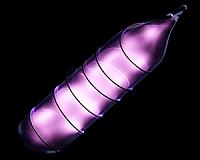| . |  |
. |
Innsbruck, Austria (SPX) May 25, 2010 Ball lightnings are circular light phenomena occurring during thunderstorms and there are a large class of reports by eyewitnesses having experienced such events. Scientists have been puzzled by the nature of these apparent fire balls for a long time. Now physicists at the University of Innsbruck have calculated that the magnetic field of long lightning strokes may produce the image of luminous shapes, also known as phosphenes, in the brain. This finding may offer an explanation for many ball lightning observations. Physicists Josef Peer and Alexander Kendl from the University of Innsbruck have studied electromagnetic fields of different types of lightning strokes occurring during thunderstorms. Their calculations suggest that the magnetic fields of a specific class of long lasting repetitive lightning discharges show the same properties as transcranial magnetic stimulation (TMS), a technique commonly used in clinical and psychiatric practice to stimulate neural activity in the human brain. Time varying and sufficiently strong magnetic fields induce electrical fields in the brain, specifically, in neurons of the visual cortex, which may invoke phosphenes. "In the clinical application of TMS, luminous and apparently real visual perceptions in varying shapes and colors within the visual field of the patients and test persons are reported and well examined," says Alexander Kendl. The Innsbruck physicists have now calculated that a near lightning stroke of long lasting thunderbolts may also generate these luminous visions, which are likely to appear as ball lightning. Their findings are published in the journal Physics Letters A. Is the mystery of ball lightning solved now? Ball lightnings are rather rare events. The majority of researchers agree that different phenomena are likely to be summarized under the collective term "ball lightning". Over time, various theories and propositions about the nature of these experiences have been suggested. Other researchers have produced luminous fire balls in the laboratory, which appeared not completely unlike ball lightning and could explain some of the observations but were mostly too short lived. Other plausible explanations for some of observations are St. Elmo's fire, luminous dust balls or small molten balls of metal. In which cases then, can a lightning bolt invoke a ball-shaped phosphene? "Lightning strokes with repetitive discharges producing stimulating magnetic fields over a period of a few seconds are rather rare and only occur in about one in one hundred events," reports physicist Kendl. "An observer located within few hundred metres of a long lightning stroke may experience a magnetic phosphene in the shape of a luminous spot." Also other sensations, such as noises or smells, may be induced. Since the term "ball lightning" is well known from media reports, observers are likely to classify lightning phosphenes as such. Alexander Kendl's hypothesis that in fact the majority of ball lightning observations are phosphenes is strongly supported by its simplicity: "Contrary to other theories describing floating fire balls, no new and other suppositions are necessary."
Share This Article With Planet Earth
Related Links University of Innsbruck Weather News at TerraDaily.com
 Helium Could Lead To More Accurate Temperature And Pressure Data
Helium Could Lead To More Accurate Temperature And Pressure DataNewark, DE (SPX) May 20, 2010 In the May 7 edition of Physical Review Letters, a journal of the American Physical Society, an international team led by University of Delaware researchers reports new findings about helium that may lead to more accurate standards for how temperature and pressure are measured. In the article, highlighted as an "Editor's Suggestion" by the journal, the scientists provide a new theoretical ... read more |
|
| The content herein, unless otherwise known to be public domain, are Copyright 1995-2010 - SpaceDaily. AFP and UPI Wire Stories are copyright Agence France-Presse and United Press International. ESA Portal Reports are copyright European Space Agency. All NASA sourced material is public domain. Additional copyrights may apply in whole or part to other bona fide parties. Advertising does not imply endorsement,agreement or approval of any opinions, statements or information provided by SpaceDaily on any Web page published or hosted by SpaceDaily. Privacy Statement |